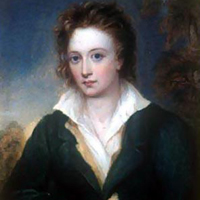Ozymandias by Percy Bysshe Shelley: Summary
The poem makes simple bare statements about the downfall of a certain tyrant called Ozymandias. The speaker in the poem reports to us what a traveler "from an antique land" told him. The traveler conjoins the past with the present. The traveler knew who Ozymandias was and what happened to his power and empire.

P. B. Shelley (1792-1822)
He now stands by the trunk less statue of the emperor Ozymandias, which lies in the vast desert landscape and tells the speaker the artistry of Ozymandias's statue and the inscription on its pedestal. The whole scene is dramatic and ironic. The poem is written almost like a sonnet with the rhyming words at the beginning and the end of it.
The poem begins with the narrative form and includes the description of the statue/pedestal by the traveler. The narrator reports what the traveler said to him. The report goes this Way:
Just see these two vast and bodiless legs of the stone statue standing in the desert. Also see the face that now is half-sunk shattered to pieces. On the face is seen certain anger. The lip is wrinkled. The face also shows the sneer and the cold command of emperor Ozymandias. The sculptor knew well the nature of the tyrant. He was passion-frenzy in dictating others. There was pride in him. The sculptor stamped the ruthless ruler’s cruel nature on his statue. The sculptor in fact mocked out the tyrant and gave full expression of all that the tyrant signified for him in the form of a grand and imposing statue that now is shattered into pieces and that now appears in its half-sunk and almost forgotten relic form. He must have given his whole heart and imagination in the formation of that statue. One can still see such words on the pedestal of the statue.
'My name is Ozymandias. I am the king of kings. Look at my works. Even the mighty people will be disappointed at seeing the grand power and authority I exercise.'
But nothing remains beside. Everything is bound to disappear from the face of the earth. The statue is decayed now. One can still see the "colossal wreck" - that vast destruction brought about by time. Now it is all bare in this desert land that stretches far.
Ozymandias's physical power was long gone to his death. He wished to be immortal by having his great statue built up which now appears only in the form of remains. The way the sculptor is said to have made the statue the reader forms the opinion that the ruler, proud as he was of his authority, must have been bad-tempered, heartless and cruel. We move from the broken fragments to what is written on the pedestal of the statue that speaks of the hastiness and the pride of the ruler. After reading the poem, we form the view that the interest of the poem is not to give the historical detail of the ruler, but to imply the character of Ozymandias, in special relation to what has happened in subsequent ages. The whole poem is a satirical piece that is directed to mocking at Ozymandias's foolish presumption and supposition that his power was permanent,
Here the poem reveals its anti-tyrannical and anti -autocratic nature and also gives us the impression that the artist and art are also time-bound and subject to death and decay. As regards the choice of words, "frown", "wrinkled lip", "cold command" are some such words that precisely depict the uncompromising and dictatorial character of Ozymandias as powerfully as the stone carvings themselves. Nowhere does the narrator see in that vast desert sand any sign of the tyrant's impression. Ozymandias death is the undignified end that reminds us of the downfall of many tyrants/emperors at the modern time.
Cite this Page!
Sharma, K.N. "Ozymandias by Percy Bysshe Shelley: Summary." BachelorandMaster, 3 July 2014, bachelorandmaster.com/britishandamericanpoetry/ozymandias-summary.html.
